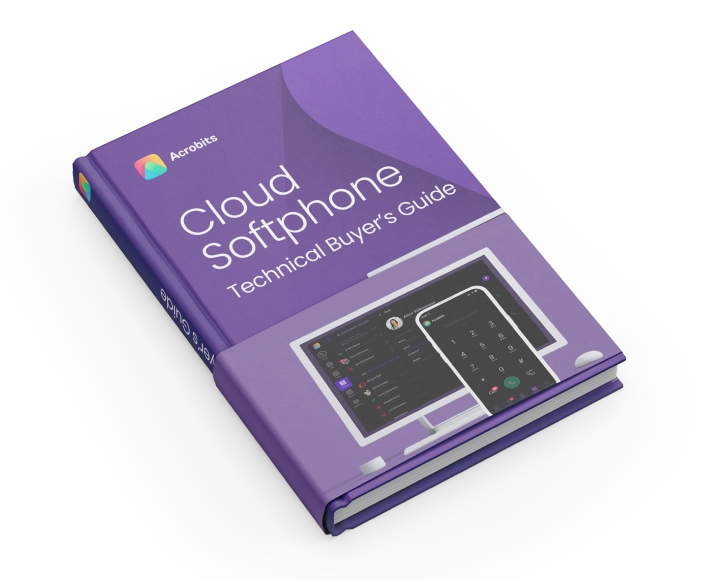
Build a white label softphone app
Create a custom white-label softphone with Cloud Softphone.
- No devs needed
- Native desktop apps
- 100+ premium features

Communication is the heart of any business, including working with people who aren’t in the office or even the same region. Whether this means remote workers, suppliers, clients, or customers — your business relies on phone systems that work without issue.
Two types of softswitches are at the heart of reliable communication but often go unnoticed by users and even IT: class 4 and class 5 softswitches.
Differences Between Class 5 and Class 4 Softswitches
Class 5 switches manage local call routing and enable advanced features for end users, while class 4 soft switches route long-distance calls. Together, they work in the background to connect businesses and customers regardless of distance.
This post will explain both types of switches and how they provide high-quality services. Understanding them will better equip you to provide and maintain dependable communication services.
A softswitch is a software-based solution that replaces traditional hardware telephone switches. VoIP networks primarily use it to route calls, manage bandwidth, and provide sought-after services like call forwarding and voicemail.
Let’s examine these two major classes of soft switches and how they work together to benefit the organization.
Class 4 and class 5 softswitches are critical VoIP network components, enabling efficient call routing and management. How do these classes vary from each other? They work together to offer a complete communication solution. Let’s break down how:
For example, a call originating in one country may be routed by a class 4 softswitch to another country, where a class 5 softswitch takes over to deliver the call to the recipient. The following table further compares these two classes of softswitches.
| Feature | Class 4 Softswitch | Class 5 Softswitch |
|---|---|---|
| Purpose | Long-distance call routing | End-user call management |
| Target Users | Wholesale carriers, large enterprises | Residential and small business users |
| Concurrent Capacity | High | Moderate |
| Features | Routing, protocol support, security | Call features, billing, authentication |
| Examples of Use Cases | International VoIP routing | Local VoIP service provision |
Both softswitches enable service providers to deliver high-quality communication services while optimizing network performance and reducing operational costs.

Softswitches replace physical hardware, and these relatively new virtualized switches handle many of the same responsibilities. We’ll break down a high-level overview of how these switches work in the context of a phone call:
Depending on the nature of the call, the above process can involve both class 4 and class 5 softswitches or only require class 5.
A class 4 softswitch is a critical component in wholesale VoIP infrastructure, as it’s designed to manage and route high volumes of long-distance and international voice traffic.
This class serves as the backbone of the telecommunications network, bridges the gap between carriers, and ensures seamless connectivity across long distances. So, let’s further break down its features and how it’s used.
What features does a class 4 softswitch bring to the table? A few standout features are:
How are class 4 switches put to work? A few common use cases include:
For example, a VoIP provider offering wholesale services may route calls from the United States to Europe. Using a class 4 softswitch, the provider can select the most efficient and cost-effective route, ensuring minimal latency and high call quality across vast distances.
A class 5 softswitch is designed to directly interface with end-users, enabling local calling and advanced communication features users have come to expect.
This class of software is critical for delivering VoIP services at the end-user level by supporting a wide range of options, services, and multi-media communication. We’ll further explore this class to underscore how it varies from class 4.
What features do class 5 softswitches bring to the table? A few standout capabilities include:
How do businesses use class 5 softswitches in reality? A few ways common use cases are:
For example, a small business needs a reliable VoIP solution for handling customer calls, internal communication, and video meetings. They’ll need a class 5 softswitch with features like call forwarding, auto-attendant, and seamless video conferencing.
We’ve explored how a class 4 softswitch primarily handles long-distance routing between carriers while class 5 softswitches manage local and regional calls. How do these two classes work together in practice?
Let’s say a long-distance call is initiated through a class 5 softswitch. The call begins within a class 5 and is routed to a class 4 softswitch to optimally reach its destination, which is then transferred back to a class 5 softswitch at the end location.
Ultimately, these classes are not mutually exclusive but work together to provide the best possible service.
Both classes of softswitches are essential for modern communications. Companies have relied on similar, hardware-based solutions to meet these needs — but now, software-based alternatives create cost-effective solutions that increase reliability and quality.
If you offer a communication platform to end users, the partner you choose for infrastructure and soft switches plays a significant role in the overall quality of your service.
Partnering with reputable, time-tested providers like Acrobits ensures a seamless experience for anyone using your services, whether they need local or long-distance services.
Legacy services with hardware-based switches simply can’t compete with modern virtual switches. Is it time to step into modern communications and leave low-quality calls behind? Book a demo with Acrobits today to learn more about how our communication tools can help.

Create a custom white-label softphone with Cloud Softphone.

The history of VoIP is full of clever hacks. Solutions that started as stopgaps, even kludges, often ended up becoming the standard way of doing things. One of the best examples is push notifications for incoming calls on softphones. What began as a workaround has become the only accepted method on mobile platforms. And Acrobits […]

Android’s greatest strength, its openness and vast device diversity, has also created its most persistent challenge for developers: fragmentation. While Apple’s iOS universe is carefully curated, Android is free to roam across more than 20,000 device types. This means every launch is met by confronting a maze of device-specific quirks, platform evolutions, and new compliance […]

The Customer Acquisition Challenge In today’s digital marketplace, ESIM providers face an increasingly difficult challenge when it comes to customer acquisition. As the industry matures, competition for keywords in digital advertising has intensified dramatically, resulting in higher customer acquisition costs across the board. Major players and emerging startups alike find themselves trapped in bidding wars […]

With more businesses relying on softphones for internal and external communication, the security of your VoIP system has never been more critical. As VoIP adoption grows, so do threats like VoIP hacks, toll fraud, and denial-of-service attacks, putting your business communications and data at risk. To stay protected, it’s essential to implement tools like SBCs […]